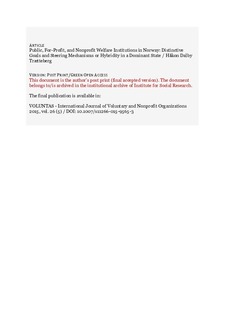Public, For-Profit, and Nonprofit Welfare Institutions in Norway: Distinctive Goals and Steering Mechanisms or Hybridity in a Dominant State
Peer reviewed, Journal article
Accepted version
Permanent lenke
http://hdl.handle.net/11250/2469527Utgivelsesdato
2015Metadata
Vis full innførselSamlinger
- Publikasjoner fra CRIStin [716]
- Tidsskriftpublikasjon [389]
Originalversjon
VOLUNTAS - International Journal of Voluntary and Nonprofit Organizations. 2015, 26 (5), 1620-1638. 10.1007/s11266-015-9565-3Sammendrag
Nonprofit, public, and for-profit welfare institutions have different operational logics. The distinctiveness of a nonprofit institution is more prominent in some circumstances than in others. This paper is based on case studies conducted in Norwegian municipalities to understand when and why nonprofits operate with distinctive steering mechanisms. Based on the framework of hybrid organizations, I analyze the interaction among institutions in the public sector that have democratic legitimacy through a hierarchical organization, the for-profit sector that seeks efficiency to compete in the market, and the nonprofit sector that has civil society logic. The study revealed how more detached demand-driven regulation of nonprofit schools gives them more room to pursue goals different from those of the public sector institutions, which can be contrasted with the supply-driven regulation of nursing homes that have far less room for steering independent of the municipalities. Surprisingly, the results also suggested that small close-knit communities influence institutions in ways that diverge from the hierarchical steering, and that this happens across the sector split. Moreover, regulation and alternative sources of income contribute to making the organization more hybrid, in the sense that the hierarchical steering is challenged.
